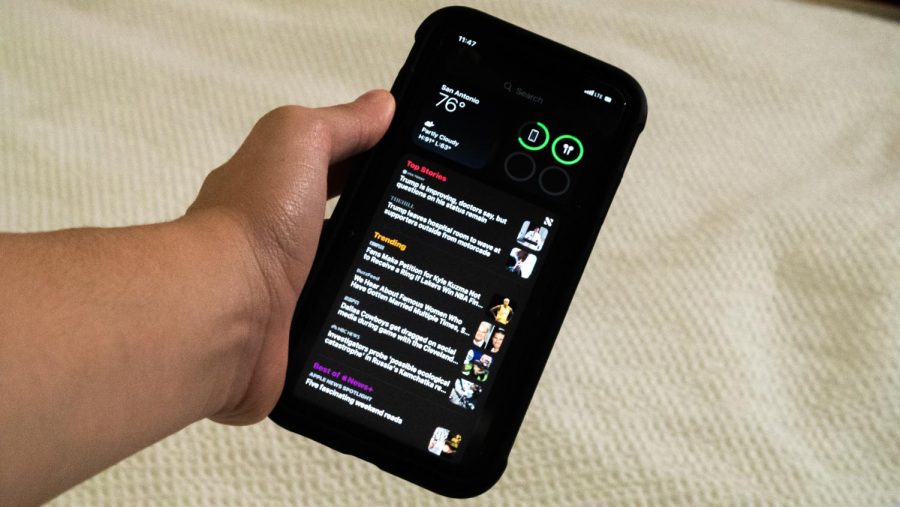 iRealize the iPhone is one of the most instrumental iThings to have been created in years. Apple CEO Steve Jobs probably does too, because it has garnered the company much iProfit.
iRealize the iPhone is one of the most instrumental iThings to have been created in years. Apple CEO Steve Jobs probably does too, because it has garnered the company much iProfit.
It is no secret the iPhone has been Apple’s newest success. With it, people can now access a computer interface on their phone.
If Apple hasn’t hooked the consumer with the iPhone, it also features the iPod Touch, which offers the same features as the iPhone except the phone. Either way, Apple will get you.
But despite its benefits, the iPhone has also transformed the world of communication and connectivity to a potentially unhealthy point of addiction. Consumers are spending hours and hours attached to an inanimate object.
So 85,000 applications later, in an all-in-one technological marvel, is the iPhone out to make other cell phones obsolete? Or did Apple release it merely to satisfy its brand’s insatiable fans?
The business boom
As a whole, Apple Inc.’s sales have gained ground compared to its archrival, Microsoft, which still remains the top dog in the technology world.
Apple sales in its fiscal fourth quarter blew expected Wall Street predictions out of the water thanks in large part to iPhone sales, according to an Oct. 19 CNNMoney.com report. In the U.S. smartphone market, iPhones have a 22 percent share, second to the BlackBerry’s 51 percent. BlackBerrys are exclusively produced by Research in Motion (RIM), a Canadian company that develops technology software.
iPhone sales rose 7 percent in the fourth quarter to a record $7.4 million, according to an Oct. 20 article by The Wall Street Journal. The company announced a total of $1.67 billion quarterly profit on Mac computers and iPhone sales in the quarter.
Apple’s sales have shown well in a recovering national economy but the smartphone demographic is still tightly concentrated, according to Eric Benderoff, editorial consultant for Appolicious, a Web site that reviews iPhone applications, and former Chicago Tribune gadget columnist.
“We’re still very early in the use of cell phones and how they’re evolving,” Benderoff said. “In my view and certainly a lot of others, Apple got it right.”
Benderoff estimated roughly 10 percent of the U.S. has a smartphone and only a fraction has the iPhone.
All-in-one e-mail, Internet, portability
The iPhone’s main appeal is the ease of access to Internet and e-mail from almost anywhere in the country. For both students and professors alike, it becomes a must-have for checking updates.
John Dagys, sports car racing reporter for SPEEDtv.com, doubled as a journalist and a student at Columbia College in Chicago until his graduation in May. Dagys said he couldn’t do both his jobs as a student and a journalist without the iPhone.
“As a journalist, I can’t imagine living without it right now,” Dagys said.
Dagys added he did not have the luxury of sending e-mails or checking the Internet on the go in his pre-iPhone life.
Bonnie Brennen, Nieman professor of journalism in the College of Communication, said her job as a professor has similarly been made much easier by the iPhone’s portability factor.
Brennen said she appreciates how the iPhone allows her to check her university and personal e-mails, especially when traveling to conferences.
But the iPhone isn’t the only option. The iPod Touch presents the same features minus the phone option and corresponding monthly costs. Other smartphone options include Blackberry’s Storm and Storm 2 (due to be released this Wednesday), the T-Mobile MyTouch 3G with Google, and the Palm Pre from Sprint.
Connie Bauer, associate professor of marketing in the College of Business Administration, has the similar iPod Touch she uses for nearly every task.
“My iPod Touch is my school and office computer,” she said.
Bauer said she has not had a computer in her office for years, as the iPod Touch’s features eliminate the need for it.
Getting app-happy
There are more than 85,000 downloadable applications from Apple’s app store. There are countless possibilities of options to pick from a distinct number of categories. Some apps are free, but others can cost as much as $28.99.
The iPhone 3GS and the older 3G model come with default apps: Messages (Text messaging and multimedia messaging services like photo or video messaging), Calendar, Photos, Camera, YouTube, Stocks, Maps (Google Maps, with Assisted GPS on the 3G and 3GS models), Weather, Clock, Calculator, Voice Memos, Notes, Settings, iTunes, (with access to the iTunes Music Store and Podcast Directory), the App Store, Compass (on the 3GS) and Contacts.
Benderoff discussed the apps appeal and how Apple perfected the use of third-party platforms on their devices.
“It’s super simple and easy for users to put their apps on the iPhone,” he said.
Meaghan Donohue, a sophomore in the College of Arts & Sciences, has roughly 96 apps (six pages) on her iPhone ranging from ESPN ScoreCenter to track her favorite teams, Wikipedia to check random facts and USA Today to check “the real news.”
“The best thing is there really is an app for everything,” she said.
[kml_flashembed publishmethod=”static” fversion=”8.0.0″ useexpressinstall=”true” movie=”http://marquettetribune.org2009/10/iPhone-CL-TDZ.swf” width=”570″ height=”440″ targetclass=”flashmovie”]
[/kml_flashembed]
Costly convenience
Having access to as many apps and features as the iPhone does comes at a price. The newer and more powerful iPhone 3GS sells for either $199 (16 GB) or $299 (32 GB). The 8 GB iPhone 3G, the older model, now sells at $99. On top of that, the iPhone requires a monthly phone and data plan for service from its exclusive carrier, AT&T.
Benderoff advised students on a budget to look more at the iPod Touch versus the iPhone.
He said the cost of operating an iPhone is roughly $100 a month, so students and parents should consider the iPod Touch because it does not require the monthly service and data plans, costing less over time.
The iPod Touch is available for $199 (8GB), $299 (32GB) or $399 (64GB). The 64 GB iPod Touch is twice as large as the current iPhone 3GS.
But as more people use Apple products, costs will come down even more, Brennen said.
Dependency cost
Sources agreed they were in love with, and perhaps addicted to, their iPhones.
Benderoff said this at its core, the iPhone is still a phone. But Dagys and Donohue might beg to differ.
“It’s funny because the iPhone is my life, and I don’t know what I would do without it,” Dagys said.
For a trip to Japan to cover a sports car race this weekend, Dagys plans to use iPhone’s Google Maps application to navigate the country and figure out his itinerary. He said it is much less of a hassle than carrying around physical maps and train schedules.
Donohue lightheartedly admitted her concern after she forgot her phone on the way to class.
“I had no time to run back and get it and I felt panicky and like I was missing part of me all morning,” she said. “I mean I couldn’t check my e-mail, or text or check the time or weather — I was dying.”
Overall, Donohue gave a grim prognosis for her iPhone attachment.
“I do love my phone, but it’s pretty much ruined me forever.”







